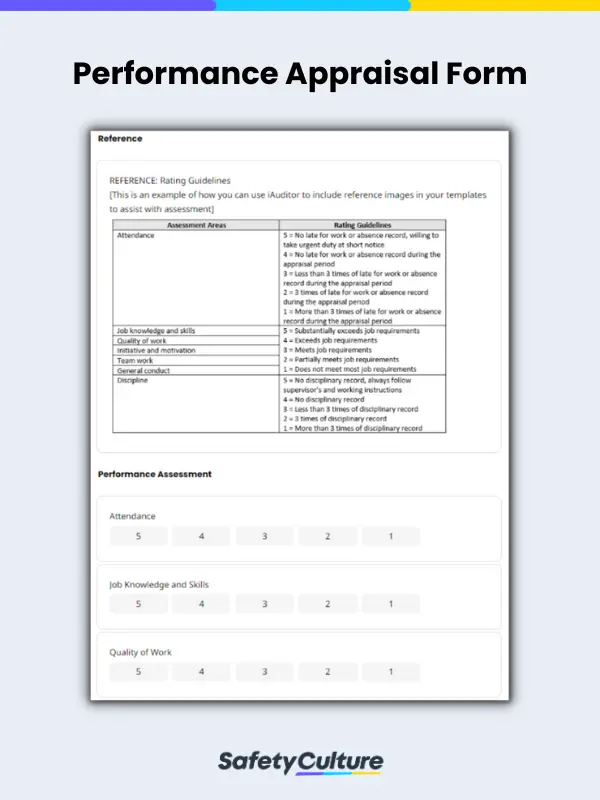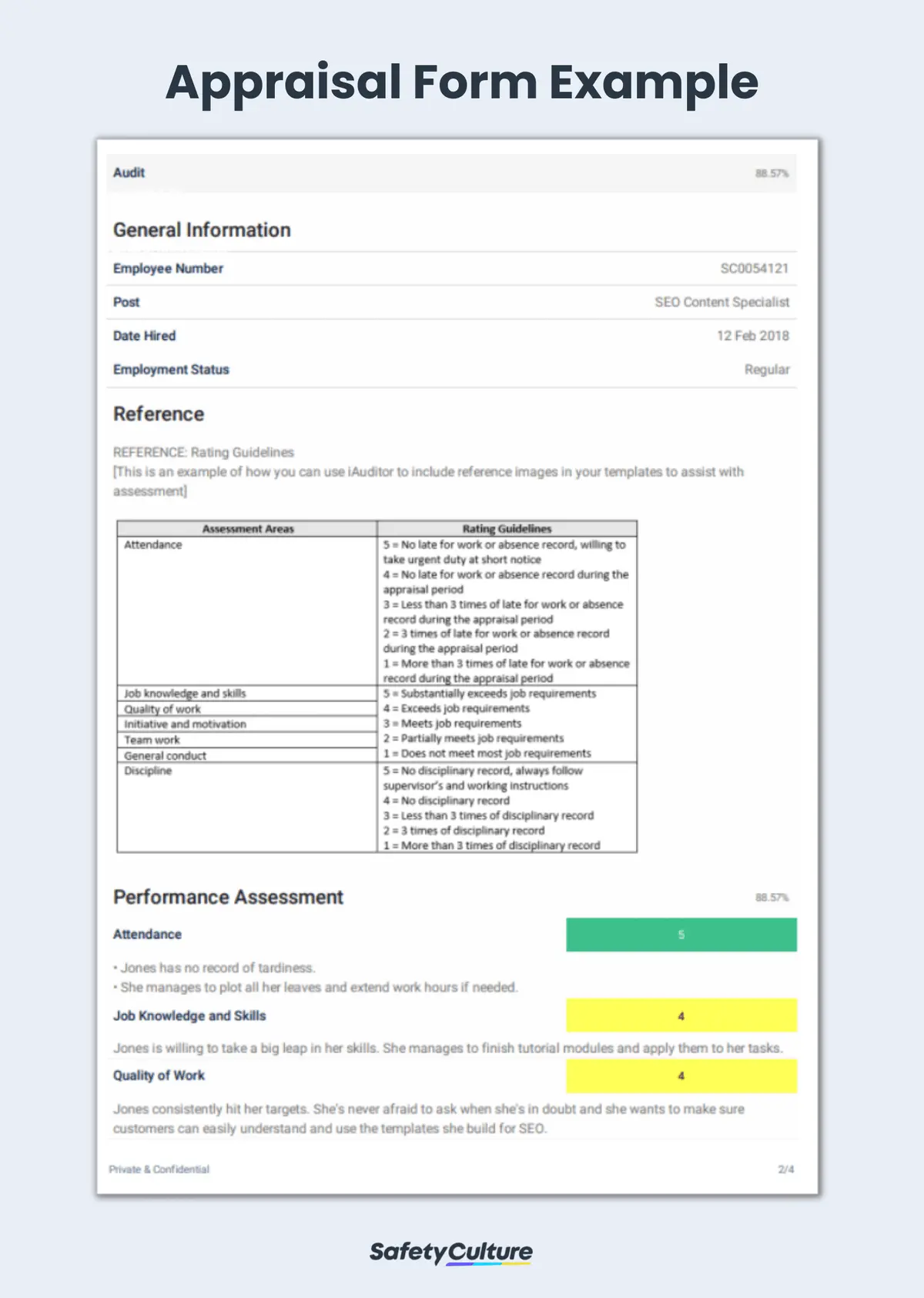What is a Performance Appraisal Form?
A performance appraisal form, also called an appraisal form, is a tool used by people managers and HR teams to measure the performance of employees during a specific timeframe. Appraisal forms help simplify the documentation of review processes and streamline performance appraisals. A well-structured appraisal process enables benchmarking across teams and divisions to identify staff career development opportunities and areas for improvement.
Performance Appraisal Form Example: What to Include in Your Template
Whether used by supervisors, the people team, or employees themselves, performance appraisal forms feature standard elements that help facilitate a complete review process. Here are the three fundamental fields of an appraisal form:
A rating system
Supervisors, and even employees themselves, rate or measure employee performance for a specific timeline using key team and business metrics. Attendance, productivity, quality of work, the achievement of targets, etc, are examples of items being rated.
Example:
| Assessment Areas | Rating Guidelines |
| Attendance | 5 = No late for work or absence record, willing to take urgent duty at short notice
4 = No late for work or absence record during the appraisal period 3 = Less than 3 times of late for work or absence record during the appraisal period 2 = 3 times of late for work or absence record during the appraisal period 1 = More than 3 times of late for work or absence record during the appraisal period |
| Job knowledge and skills | 5 = Substantially exceeds job requirements
4 = Exceeds job requirements 3 = Meets job requirements 2 = Partially meets job requirements 1 = Does not meet most job requirements |
| Quality of work | |
| Initiative and motivation | |
| Teamwork | |
| General conduct | |
| Discipline | 5 = No disciplinary record, always follow supervisor’s and working instruction
4 = No disciplinary record 3 = Less than 3 times of disciplinary record 2 = 3 times of disciplinary record 1 = More than 3 times of disciplinary record |
Feedback
An appraisal sheet can include sections for qualitative feedback from peers or supervisors mentioning employee commendations or opportunities for improvement.
Here’s an example using the rating guideline above:
| Attendance | |
| Score | 5 |
| Feedback |
|
| Job Knowledge and Skills | |
| Score | 4 |
| Feedback |
|
Acknowledgment
The ratings and contents of employee appraisals need to be acknowledged or confirmed by both employees and supervisors. Appraisal forms typically include the signatures of both employees and supervisors to confirm the validity of the appraisal.
To give you a better understanding, we’ve created a filled out example of an appraisal form using a digital staff performance appraisal checklist template.
Which Format Should We Use?
Performance appraisals can be a daunting task because of how tedious the entire process can be. Choosing the right appraisal format for a company’s specific context can help make it easier for all stakeholders—human resource coordinator, finance head, direct manager, colleagues, and subordinates—to efficiently carry out appraisals as hassle-free as possible. Listed below are the two most common types and performance appraisal form examples you can try implementing in your workplace:
360-Degree
A 360-degree performance review is probably the most comprehensive appraisal format as it entails feedback not only from your direct manager and team members, but also from your peers and in some cases, from the boss of your boss and department heads. This appraisal format is for organizations that can spare enough time, effort, and resources and have adequately trained personnel for executing 360-degree appraisals. Sample 360-degree appraisal format questions include:
- Are this employee’s solutions to problems clear and effective?
- Does the employee take the lead on projects or assignments?
- Do you believe this employee is honest, ethical, and trustworthy?
Management by Objectives (MBOs)
MBO is an appraisal format, where at the beginning of each period such as quarterly, biennially, or annually and upon the approval of upper management, both the employee and his/her manager set objectives and key results aligned with the overall company goals, and at the end of each period, evaluate the former’s performance warrants a pay increase based on meeting set objectives.
For small- to medium-sized companies, MBOs can be the most optimal appraisal format to practice as the process is more manageable at their scale and it can still be easily monitored and followed through for continued professional and business growth. The two most common types of MBOs with examples are:
Performance Objectives
- Increase mobile app downloads by 15% through carrying out at least 5 experiments that improve user experience
Reach 10,000 more customers who use our product at least once a week by integrating it with a new feature
Personal Development Objectives
- Master SafetyCulture analytics by knowing exactly how I can get the data I need on my own
- Develop better work relationships by participating in our team lunch time every Wednesday
How to Fill Appraisal Form
When filling out performance evaluation forms and other performance appraisal forms, employees and the management can use the following reminders as a guide:
- Identify assessment criteria by reading the instruction carefully
- Review the employee’s goals and objectives to determine if they were able to achieve them
- Collect relevant information which can include records of projects completed, client feedback, and performance metrics
- Provide specific examples that demonstrate employee strengths or areas for improvement
- Evaluate strengths and achievements, and address areas for improvement
- Establish SMART goals for the upcoming assessment period
- Maintain a professional tone and be respectful tone when filling out the form
FAQs about Performance Appraisal
Performance appraisal forms can be used to assess and evaluate an employee’s overall performance, provide feedback, and recognize their accomplishments. Performance appraisals, though ready-to-use templates, play a significant role in fostering employee growth and development, enhancing communication, and aligning employee efforts with organizational goals.
When writing appraisal forms, it’s important to provide clear, specific, and objective feedback on employee’s performance. Outlines may vary depending on the organizational standards. Here are some of the items that should be included in the appraisal form:
- Goals – Indicate achievements and milestones throughout the year with respect to the annual goals that have been set with the manager in the previous cycle.
- Key Performance Indicators (KPIs) – Include the key progress and strategic improvements that have been achieved during the performance review cycle.
- Development areas – Indicate failures with a positive reaffirmation.
- Disciplinary acts – Employee appraisals don’t only cover job performances but encompass employee attitude towards work as well.
- Future Plans – Cover additional learnings or skills that would help employees to achieve other goals to improve current performances.
The most effective way to complete a performance appraisal can be summarized into five steps: 1) Assess previous and current performance; 2) Conduct a one-on-one interview with the employee; 3) Create action plans; 4) Set future goals; and 5) Document and obtain signatures.
Read more about how to conduct a performance appraisal.
Yes, it is a good practice for employees to do an evaluation of their own performance because it enables them to reflect on their objectives and areas for improvement. Self-appraisals are also often a valuable component for the management to conduct a comprehensive periodic employee assessment. With a performance appraisal form, it also gets easier to perform self-appraisal.




